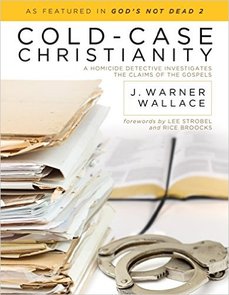
Cold Case Christianity: A Homicide Detective Investigates the Claims of the Gospels by J. Warner Wallace, published by David C. Cook, 2013. Available on Amazon in a number of formats, including an audiobook from audible.com, also from Christianbook.com. Visit the author’s website at Cold Case Christianity.
I’m always getting great ideas from my pastor! On Easter Sunday he mentioned a book that sounded so intriguing: written by a former police detective, applying the rules of evidence to the Resurrection of Christ.
So I went online to my lovely, lovely library system, Arapahoe County Libraries, to see if it was available. (If it were available?) And it was, but only as an audiobook. I’ve always resisted audiobooks because I say that I read silently much faster than someone else can read aloud, so what’s the point? But since I really wanted to get started on this (and I’m too cheap to buy books, most of the time) I went ahead and checked it out. Well, is my face red! It suddenly occurred to me that while yes, I can read fairly fast, I can’t read while I’m doing other things such as cooking, cleaning, folding laundry, gardening, driving, etc., etc. What am I usually doing while engaged in those activities? Listening to something: the radio, a podcast, or (if I’m being really productive, so hardly ever) the music we’re currently performing in the Cherry Creek Chorale. You want to know how long this audiobook was? Eight hours, 26 minutes, and 29 seconds. Sounds pretty grueling, but I got through it in about a week just by having it on while I was doing other stuff.
So now I’m hooked on the whole audiobook idea, but not every book is available through the library, and audiobooks are quite expensive. (Having struggled to get started reading my own book as an audio version I can understand why. It’s a long process.) The book I’m reading right now, Naked Money by Charles Wheelan, isn’t available from the library as anything but a paper-and-ink version. (I said to Gideon and Jim a couple of nights ago, “Well, I’m going upstairs to read my primitive paper-and-ink book!”) So maybe I’ll give in to the lure of all those audible.com ads. (It’s kind of funny when you think about it: audible.com is selling something that used to be an automatic part of every literate person’s life, listening to someone read aloud.) Think of the acres and acres of cross-stitching I could have done over the years if I’d been lying on the couch listening and stitching instead of lying on the couch reading. Ah well.
Anyway, back to the book at hand. Wallace draws from two deep wells here: his faith and his experience. There’s a tendency to think in our modern society that a sharply-defined conflict exists between the spiritual and the scientific, but that simply isn’t so. Wallace uses actual situations from his days as a police detective and then applies them to the biblical narrative. Here’s one example of how this works: Critics of the Gospels, including Bart Ehrman, always point out that there are discrepancies among them. Several years ago I put together a little play dramatizing the events on that first Easter morning, and it was a difficult process! How many angels were there at the tomb? Where were they? Who said what to whom? Who got to the tomb first? Etc. Wallace points out that these are exactly the discrepancies we would expect in real eyewitness accounts. When every account is identical, you know that there has been collusion, intentional or not. Wallace gives an example of this happening with a case he investigated. There had been a robbery with several witnesses. It was raining, and the responding officers wanted to be nice to said witnesses, so they let them get into the back of a police van to wait for the detectives, one of whom was Wallace. Well, when he started interviewing those people he realized that they were all giving exactly the same story. How could this be? They were genuine witnesses. Then he realized that they had had a chance to confer, huddled in the van. Their stories had been contaminated.
So, when you look at different versions of the Resurrection and its aftermath, you see that the central ideas are very clear: the tomb was empty because Jesus had risen from the dead. He was seen a number of times afterwards by a number of people. One narrator remembers the specific details one way, another one, another way. Those differences support the validity of the accounts. I was raised in a denomination that very much emphasized the inerrancy and authority of the Bible (a good thing) but which was very reluctant to allow much in the way of humanity into it (a sort-of-bad thing). The old King James Version (which, as I’m sure I’ve said before, is embedded into my software) says, “For the prophecy came not in old time by the will of man, but holy men of God spake as they were moved by the Holy Spirit” (II Peter 1:21, and that’s second Peter, not two Peter). So we tended to emphasize the “moved by the Holy Spirit” part of that verse but not the “holy men of God spake” part. They’re both there, though.
If you’ve always thought, ‘Oh well, the Bible is full of contradictions,’ then maybe you should take a look or listen to this book, because those supposed contradictions may be the very things that reveal the Bible’s truth. And if you’re a Christian who finds him- or herself sometimes tongue-tied as you try to defend your faith, well, Wallace’s ideas can be very helpful. Well worth whatever amount of time you want to invest!
So glad you are now hooked on audiobooks! I can’t wait to listen to borrowed copy from the library too!